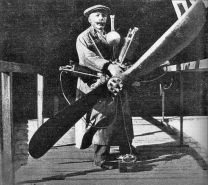
Tazio Giorgio Nuvolari was an Italian racing driver. He first raced motorcycles and then concentrated on sports cars and single-seaters. Originally of Mantua, he was nicknamed Il Mantovano Volante and Nuvola ("Cloud"). His victories—72 major races, 150 in all—included 24 Grands Prix, five Coppa Cianos, two Mille Miglias, two Targa Florios, two RAC Tourist Trophies, a Le Mans 24-hour race, and a European Championship in Grand Prix racing. Ferdinand Porsche called him "the greatest driver of the past, the present, and the future".

Achille Varzi was an Italian Grand Prix driver. He was the winner of Formula 1's first recorded race.
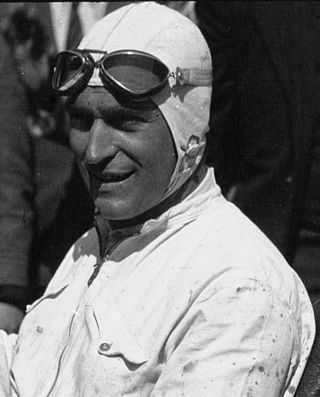
Luigi Cristiano Fagioli, nicknamed "the Abruzzi robber", was an Italian motor racing driver. Having won his last race at 53 years old, Fagioli holds the record for the oldest Formula One driver to win a race. He is also the only Formula One Grand Prix winner born in the 19th century, and the only Grand Prix racing driver to have won a championship race in both the AIACR European Championship and the World Drivers' Championship.

The Coppa Ciano was an automobile race held in Italy. Originally referred to as Coppa Montenero or Circuito Montenero, the Coppa Ciano name was officially in use between 1927 and 1939.

Baconin Borzacchini was an Italian Grand Prix motor racing driver often referred to as Mario Umberto Borzacchini.
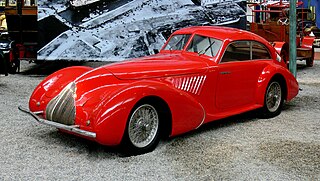
The Alfa Romeo 8C was a range of Alfa Romeo road, race and sports cars of the 1930s.
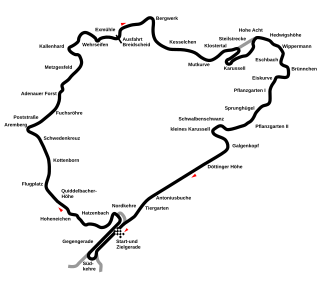
The 1935 German Grand Prix was a Grand Prix motor race held at the Nürburgring on 28 July 1935.
Mario Mazzacurati was an Italian engineer and auto racer driver active in South Africa, winner of the 1936 South African Grand Prix in Bugatti cars with pseudonym Mario Massacuratti.

The Alfa Romeo P3, P3 monoposto or Tipo B was a classic Grand Prix car designed by Vittorio Jano, one of the Alfa Romeo 8C models. The P3 was first genuine single-seat Grand Prix racing car and Alfa Romeo's second monoposto after Tipo A monoposto (1931). It was based on the earlier successful Alfa Romeo P2. Taking lessons learned from that car, Jano went back to the drawing board to design a car that could last longer race distances.
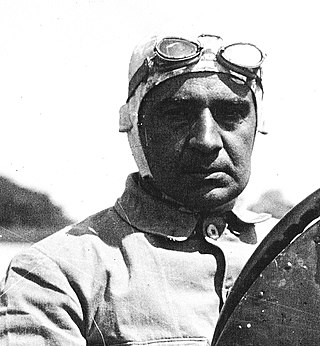
Ferdinando "Nando" Minoia was an Italian racing driver with an exceptionally long, distinguished and varied career. In 1907, he won the Coppa Florio driving an Isotta Fraschini. In 1923, he drove the world’s first mid-engine Grand Prix car, the Benz Tropfenwagen. In 1927, he won the inaugural Mille Miglia driving an OM. Finally, in 1931 he became the first European Champion, driving for Alfa Romeo, but without winning a single event.

The 1935 Grand Prix season was the second year of the new 750 kg Formula. The success of the previous year encouraged the AIACR to reinitiate the European Championship. It was composed of the seven national Grands Prix and was won by Rudolf Caracciola, driving for the Mercedes-Benz team. The team dominated the season winning five of those Grand Épreuves, as well as four of the other major races of the season. However, in one of the great motor-races in sporting history, Tazio Nuvolari in a Scuderia Ferrari Alfa Romeo beat the combined numbers of the German teams in their home Grand Prix. The season also saw the arrival on the international stage of the bright young talent Bernd Rosemeyer in the Auto Union team.

The Maserati 4CL and its derived sister model the Maserati 4CLT are single-seat open-wheel Grand Prix racing cars that were designed and built by Maserati. The 4CL was introduced at the beginning of the 1939 season, as a rival to the Alfa Romeo 158 and various ERA models in the voiturette class of international Grand Prix motor racing. Although racing ceased during World War II, the 4CL was one of the front running models at the resumption of racing in the late 1940s. Experiments with two-stage supercharging and tubular chassis construction eventually led to the introduction of the revised 4CLT model in 1948. The 4CLT was steadily upgraded and updated over the following two years, resulting in the ultimate 4CLT/50 model, introduced for the inaugural year of the Formula One World Championship in 1950. In the immediate post-war period, and the first two years of the Formula One category, the 4CLT was the car of choice for many privateer entrants, leading to numerous examples being involved in most races during this period.

The 1933 Grand Prix season was an intermediate year, as it would be the last season for the current AIACR regulations before a new weight-formula was introduced in 1934. As such, the European Championship was not held and the manufacturers held back on further developments of their existing models. Alfa Romeo, following an Italian government financial bailout and like Mercedes-Benz the previous year, had shut down its Alfa Corse works team. Scuderia Ferrari, their regular customer team took up the role of racing Alfa Romeos and a number of ex-works drivers moved across to join their ranks. They were not allowed, however, to buy the impressive Tipo B that had been so dominant in the previous season.

The Alfa Romeo Tipo 308 or 8C-308 is a Grand Prix racing car made for the 3 litre class in 1938. Only four cars were produced, actually modified from Tipo C with the engine mounted lower into the chassis and a slimmer body. The chassis was derived from the Tipo C and the engine from the 8C 2900. The 308 was engineered by Gioacchino Colombo under the control of Enzo Ferrari who was then in charge of Alfa's racing team, Alfa Corse. The car debuted at the Pau Grand Prix in 1938, where two cars were entered to race, one for Tazio Nuvolari and the other for Luigi Villoresi. Both drivers had to withdraw from competition, however Nuvolari had by then set a lap record. The next race was the Tripoli Grand Prix. The new 312 and 316 were entered, but they had engine trouble during practice and Clemente Biondetti took the start at the wheel of the 308 held in reserve. He failed to finish, while Hermann Lang, driving a Mercedes-Benz W154, was the winner. In this race, Eugenio Siena, driving a 312, was killed after hitting a wall.
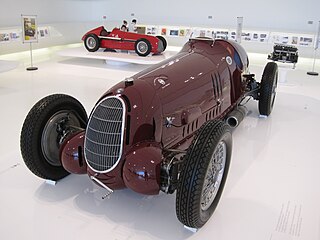
The Alfa Romeo 12C or Tipo C was a 12-cylinder Grand Prix car. The 12C-36 made its debut in Tripoli Grand Prix 1936, and the 12C-37 in Coppa Acerbo 1937. The 12C-36 was a Tipo C fitted with the new V12 instead of the 3.8 litre straight-eight of the 8C-35. The 12C-37 was a new car, with a lower chassis and an engine bored and stroked to 4475 cc, now with roller- instead of plain bearings and two smaller superchargers instead of a single large one. The car suffered poor handling, which could not be cured in time for the 1937 Italian GP, and thus was not successful. This is given as the reason for Vittorio Jano's resignation from Alfa Romeo at the end of 1937. The 12C-36 used the existing six Tipo C chassis. Four examples of the 12C-37 were built, although only two were actually assembled for the 1937 Coppa Acerbo and Italian GP. Early in 1938, the Tipo C chassis were modified into 308s, with the straight-eight engine fitted lower in the chassis and a completely new body. The four 12C-37 chassis were instead assembled into 312 and 316 formula race cars.

Luigi Arcangeli was an Italian motorcycle and car racer.

The 1923 Grand Prix season was part of a watershed year for motor racing that saw significant advances in motor-racing engineering, design and events. Fiat's chief designer, Guido Fornaca, developed the 805, the first supercharged car to win a Grand Prix. Benz appeared with the first mid-engined racer and, along with Bugatti and Voisin, produced some of the first efforts at aerodynamics on racing cars. With the United States also adopting the 2-litre formula, Harry Miller could use the smaller engine size to design the first single-seater race-car, ideally suited to American oval racing.

The Autòdrom de Sitges-Terramar is a former racing circuit located in the small village of Rocamar, in Sant Pere de Ribes near Sitges in Barcelona, Catalonia, Spain. It was built in 1923 within 300 days, and was one of the first racetracks in the world. At the time, Europe had only two racetracks, Brooklands and Monza, and the United States only had Indianapolis. Although minor races were sporadically held on the circuit through the 1950s, it was largely abandoned after the inaugural season of 1923. Now, it has seen use only as the backdrop to a selection of car advertisements, an outing of The Grand Tour, and as a chicken farm.
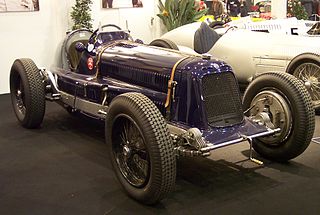
The Maserati 8CM is a Grand Prix race car produced by Italian manufacturer Maserati in Bologna between 1933 and 1935.
Henry Leslie Brooke, was a British racing driver from England. He competed in various classes of racing, including non-championship Formula One, the Le Mans 24-hour race and the Monte Carlo Rally, in the 1930s, 1940s and 1950s.

